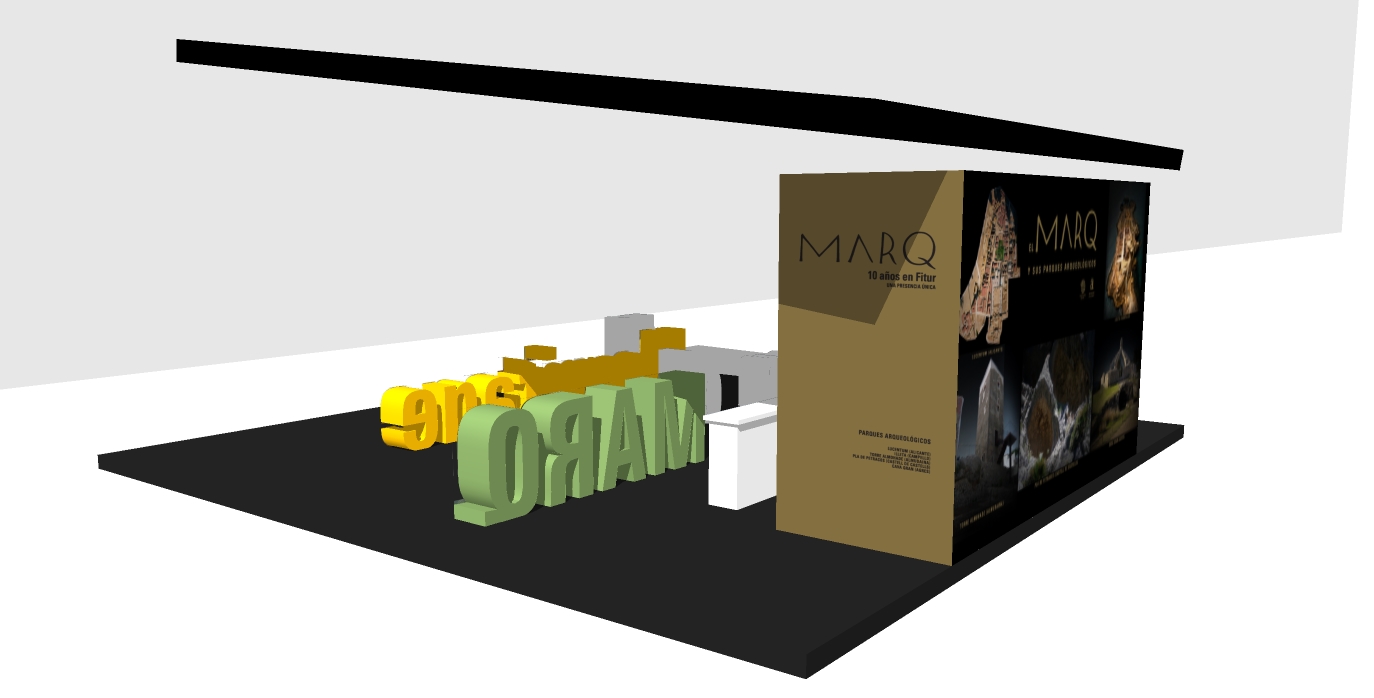THE MARQ AT FITUR. A UNIQUE PRESENCE

Conceptual, minimal and theatrical
For the last three years, MARQ's presence at FITUR has been expressed through the Museum's major exhibition of the year.
This strategy has been very well received by visitors to FITUR, and has made it possible to make the MARQ visible and, of course, to enhance its value in the face of so many tourist, cultural and social offers.
With regard to the above, it should be noted that the MARQ is one of the few museums to have its own stand at FITUR, and the only one to have done so without interruption since 2001; so this 2011 edition celebrates its 10th anniversary of participation in the most important international tourism event held in our country.
In 2009 it was the British Museum and the exhibition of the Greek art "Discobolus", entitled "The Beauty of the Body". In 2010, it was the Louvre and the great Egyptian exhibition "The Enigma of the Mummy". And now, in 2011, the star of the show is the Hermitage Museum, one of the largest museums in the world, which has an exceptional collection of art from Ancient Greece and Rome, as well as prehistoric art, the material culture of Eurasian peoples, in particular from the Scythian culture, up to the medieval period and the modern age, with the birth of Russia as a nation.
If the creativity of 2009 was based on a performance of the "art box", as a metaphor for the journey of a collection, dramatised by a choreographic game of "workers in action", dismantling the collection and presenting it for the first time to visitors to FITUR. The creativity of 2010 was based on the "icon" par excellence of archaeological Egypt: the Great Pyramid, this year 2011, overwhelmed by the importance of the event, the collection and the museum, we have opted for a conceptual discourse, where the names of the museums, Hermitage and MARQ, will be visualised in a corporeal text, in the manner of a forest that can be walked through on the exhibition surface.
A common denominator in this new creative line of MARQ, in its presence at FITUR: the conceptual -the concept as a form of communication, the minimal -absence of the superfluous and intensity of the idea- and the theatrical -The exhibition dramatisation, where light, sound, image and even technology create an atmosphere that, from the contemporary, points out the beauty of the classic and the ancient.
This year's scenography, based on giant letters that construct the phrase: "The Hermitage in the MARQ", and even its reverse side "The MARQ in the Hermitage", plays with the idea of a walk through luminous letters that hide the "treasure" of the collection and that, when visitors walk through them, allow for a dialogue between text and people.
The atmosphere of space
Beyond the literary forest -cultural, in short-, the space is a place where sound and image coexist in an atmospheric way.
On sound: a live string quartet will perform works by Russian composers of the 19th and 20th centuries. Tchaikovsky, Rimsky-Korsakov, Glinka, Rachmaninoff, Prokofiev, and Shostakovich, as well as Khachaturian, Skriabin, Kabalevsky and others will be the sound artwork that will immerse us in a "very Russian" atmosphere.
About the imageThe museum's large screen will show Russian cinema, with moving images of the last Tsars and the October Revolution. In addition to serving as a tool to show works from the collection, MARQ's visit to St. Petersburg, MARQ's presence in the museum and images of the museum's history and its present.
Unique events
Two more pieces of news about MARQ's presence at FITUR: that 2011 marks 10 years of presence at FITUR, a fact that highlights the importance that MARQ attaches to this annual event with the world of tourism, and to commemorate these ten years of presence, MARQ presents the history of the ".living archaeologyThe museum's "The Museum's exhibitions" is presented through a chronological inventory of the major exhibitions. In this context, the "archaeological parks"The sites, which make up the MARQ's living ensemble. Precisely this is the axis on which the DVD"The MARQ and its archaeological parks". with which the Alicante museum is competing for the Best Active Tourism Product Award at this year's FITUR.

Welcome
The theatrical and conceptual combination of elements such as cinema, music, typography, colour - very Hermitage (green, white and gold), as well as the presence of video screens, a bookshop and a public service desk welcome FITUR visitors to the MARQ space.
Welcome to the Hermitage at MARQ!
The Hermitage
The Hermitage Museum in St. Petersburg, Russia, is one of the finest art and antiquities museums in the world.
Architecturally, it consists of six buildings - on the banks of the Neva River - the best known of which is the Winter Palace, the official residence of the former Tsars.
Its collection, made up of more than 3 million pieces, is, together with the Louvre and the Prado Museum, one of the most complete art galleries in the world.
Created by Catherine the Great in 1764, it created the basis for the collections that are legendary today and it was in the 18th century that the largest collections in the museum's history were acquired. It was a private collection, the largest collection in Europe.
It was Nicholas I in 1852 that turned the Hermitage into an Imperial Museum, open to the public. It was on 25 October 1917 that the Hermitage Museum was declared a State Museum, a cultural centre was created and non-permanent exhibitions began, a museum of universal culture was born.
The Hermitage is currently expanding internationally, with the Guggenheim Hermitage in Las Vegas, USA, the Hermitage Amsterdam in the Netherlands and the Hermitage at Somerset House in London.
